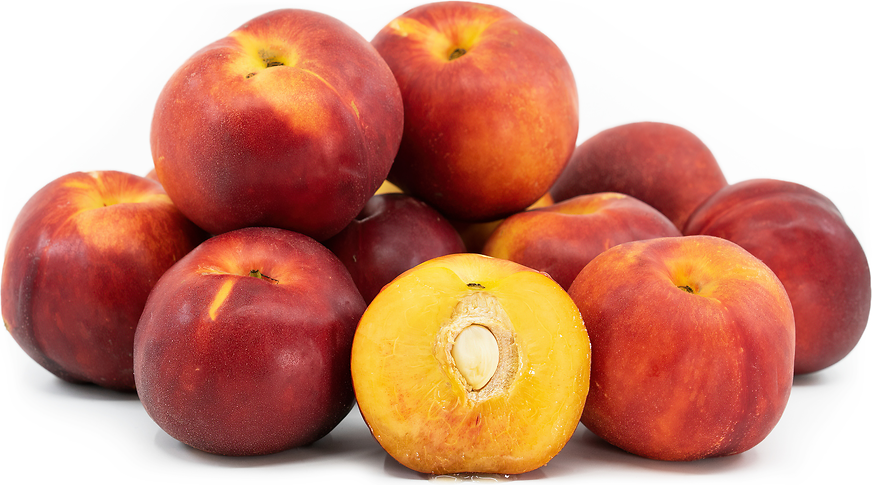


Yellow Nectarines
Estimated Inventory, cs : 0
This item was last sold on : 07/09/25
Description/Taste
Yellow nectarines are a round stone fruit that grows on trees. Their spherical body has a central groove that gives the fruit its slight heart shape. Nectarines measure about 9 centimeters in diameter. They weigh around 5 ounces and are relatively denser than other fruits of the same size. Nectarines' dark red and golden yellow skin is thin and covered with tiny yellow dots. Their succulent yellow flesh is initially hard and fibrous but becomes softer as the fruit ripens. The flesh surrounds a hard, shriveled beige pit that takes up about half of the fruits’ content. Nectarines have a fruity, tangy, and sweet aroma. Their flavor is similarly sweet and slightly tart, with subtle acidic undertones.
Seasons/Availability
Seasonal availability is dependent on the region they're grown in. Yellow nectarines are generally harvested from late spring to summer. In the Southern Hemisphere, the peak season is typically from November to March and in the Northern Hemisphere, it's from May to September.
Current Facts
The botanical name for Yellow nectarines is Prunus persica var. nucipersica and they belong to the Rosaceae family, which also includes peaches, cherries, apricots, plums, and almonds. Nectarines have either yellow or white flesh. White nectarines are typically sweeter and less acidic while Yellow nectarines have a tarter taste. Yellow nectarines are semi-clingstone fruits, meaning they have a sweet taste and the pit is attached to the flesh, but they are still easy to eat. Though genetically the same as peaches, nectarines possess a recessive gene that eliminates the fuzz on their skin. The absence of fuzz is why they are brighter in color and more easily bruised. Nectarines occasionally grow on peach trees due to bud mutations.
Nutritional Value
Yellow nectarines are a good source of vitamin C, a nutrient essential for immune and skin health, protection against infections, and iron absorption. They contain copper and niacin which are important for healthy blood vessels, nerves and bone health, red blood cell formation, skin health, digestion, and lowering cholesterol levels. Yellow nectarines are a source of fluoride and fiber that may help regulate blood sugar levels, improve heart health, promote dental health, and prevent cavities. Like peaches, nectarines were used in traditional Chinese medicine to treat mild ailments like stomach aches, digestive issues, constipation, and menstrual pain.
Applications
Yellow nectarines can be used in both sweet and savory dishes and are often consumed raw, though they may also be roasted, dried, baked, or canned. Fresh Yellow nectarines can be eaten as a stand alone snack or tossed into a fruit salad, yogurt parfait, nectarine salsa, ceviche, or used as a decoration on top of desserts. They can be used to make Yellow nectarine juice, blended into smoothies, or infused into a fruity cocktail. Yellow nectarines can be sliced in half and roasted with oil and balsamic vinegar to be enjoyed as is or used as a topping for pizza, pies, cobblers, tarts, or a warm salad served with beets, cherry tomatoes, figs, mozzarella, and nuts. Like peaches, Yellow nectarines are often preserved by canning or used in jams, jellies, and fruit sauces. They pair well with peaches, mangos, blueberries, radishes, cucumbers, limes, lemons, tomatoes, shallots, walnuts, pistachios, feta and blue cheese, basil, spinach, arugula, prosciutto, bacon, and shrimp. Yellow nectarines should be stored at room temperature until they are no longer firm. Once soft, they can stored in the refrigerator for up to five days.
Ethnic/Cultural Info
Nectarines have been growing in China for over 2,000 years. It’s speculated that the first nectarines were yellow-fleshed rather than white and were discovered growing on a peach tree. Nectarines were cultivated in ancient Greece, Rome, and Persia. In Greece, the juice from nectarines was deemed the “drink of the gods”. They started growing in Great Britain around the late 16th century and were eventually brought to America by the Spaniards in the 19th century. The nectarine industry in the United States is predominantly centered in California, where 95% of the country's nectarines are grown. This nectarine industry emerged in the 1950s when varieties were crossbred with peaches to create a hardier and more flavorful fruit. Today, France is one of the major producers of nectarines, although China remains the leader, producing tens of millions of tons each year.
Geography/History
Yellow nectarines are native to China. They grow in warm climates with plentiful sunshine, rainy winters, and dry summers. Nectarines are not typically found in the wild and are instead harvested for commercial production and in home gardens. They spread from their native Asia to the rest of the world by way of trade routes and eventually Spanish colonization that brought them to the Americas. Yellow nectarines are a popular fruit that can be found in grocery stores and farmers' markets throughout the world. They can be grown in home gardens in suitable climates.
Featured Restaurants
Restaurants currently purchasing this product as an ingredient for their menu.
| Stake Chophouse & Bar | Coronado CA | 619-522-0077 |
| Golden Door | San Marcos CA | 760-761-4142 |
| C 2 C | San Diego CA | 619-972-9345 |
| Hotel La Jolla - Sea & Sky | La Jolla CA | 858-459-0261 |
| Wolf In the Woods | San Diego CA | 619-851-7275 |
| Campfire | Carlsbad CA | 760-637-5121 |
| Marisi La Jolla | La Jolla CA | 951-852-6730 |
| Pacific Yacht Agents | Los Angeles CA | 808-214-0970 |
| Communion | San Diego CA | 619-606-5568 |
| Fairmont Grand Del Mar | San Diego CA | 858-314-1975 |

















